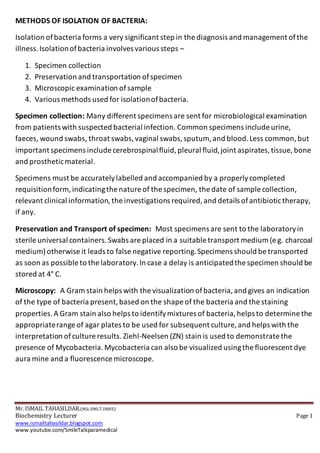
methods of isolation of bacteria
- 1. Mr. ISMAIL TAHASILDAR.(MSc.DMLT.DNHE) Biochemistry Lecturer Page 1 www.ismailtahasildar.blogspot.com www.youtube.com/SmileTalkparamedical METHODS OF ISOLATION OF BACTERIA: Isolation ofbacteria forms a very significant step in the diagnosis and management ofthe illness.Isolationofbacteria involves various steps – 1. Specimen collection 2. Preservation and transportation ofspecimen 3. Microscopic examination ofsample 4. Various methods used for isolationofbacteria. Specimen collection: Many different specimens are sent for microbiological examination from patients with suspected bacterial infection. Common specimens include urine, faeces, wound swabs, throat swabs,vaginal swabs,sputum, and blood.Less common,but important specimens include cerebrospinalfluid,pleural fluid,joint aspirates,tissue, bone and prostheticmaterial. Specimens must be accuratelylabelled and accompanied by a properlycompleted requisitionform, indicatingthe nature of the specimen, the date of sample collection, relevant clinical information,the investigations required,and details ofantibiotictherapy, if any. Preservation and Transport of specimen: Most specimens are sent to the laboratoryin sterile universal containers.Swabs are placed in a suitable transport medium (e g. charcoal medium)otherwise it leads to false negative reporting.Specimens should be transported as soon as possible to the laboratory.In case a delay is anticipatedthe specimen should be stored at 4° C. Microscopy: A Gram stain helps with the visualization ofbacteria,and gives an indication of the type of bacteria present,based on the shape of the bacteria and the staining properties. A Gram stain also helps to identifymixtures of bacteria,helps to determine the appropriaterange of agar plates to be used for subsequent culture, and helps with the interpretation ofculture results. Ziehl-Neelsen (ZN) stain is used to demonstrate the presence of Mycobacteria.Mycobacteria can also be visualized usingthe fluorescent dye aura mine and a fluorescence microscope.
- 2. Mr. ISMAIL TAHASILDAR.(MSc.DMLT.DNHE) Biochemistry Lecturer Page 2 www.ismailtahasildar.blogspot.com www.youtube.com/SmileTalkparamedical Methods of isolation of bacteria can be broadly classified into 1. Culture methods 2. On Solid media 3. On Liquid media 4. Automated systems 5. Non-culture methods Culture methods: The specimens received in the laboratoryare plated on the culture media.The appropriateculture media is selected dependingupon the bacteria suspected.The followingprecautions need to be taken into considerationwhen the culture methods are processed. 1. Optimal atmosphericconditions 2. Optimal temperature 3. Growth requirement ofthe bacteria. 1. CULTURE ON SOLID MEDIA: The principal method forthe detection ofbacteria from clinical specimens is by culture on solid culture media.Bacteria grow on the surface of culture media to produce distinct colonies. e.g. blood,peptone and sugars and other factors (e.g. buffers, salts and indicators). 2. Culture in liquid media: Bacteria can also be grown in liquid media (broth).Like agar plates,broth cultures maybe non-selectiveorselective. Bacterial growth is easy to detect as the clear liquid turns turbid,usuallywithin 24–48hr, but incubationmayneed to be extended to 14 days or more. e.g. for detection of bacteria from CSF, or to detect small numbers of Salmonella in a stool sample containingmanymillions ofother bacteria.
- 3. Mr. ISMAIL TAHASILDAR.(MSc.DMLT.DNHE) Biochemistry Lecturer Page 3 www.ismailtahasildar.blogspot.com www.youtube.com/SmileTalkparamedical 3. Automated system: Automated blood culture systems eg. BACTEC,Bacte Alert utilizes liquid culture.Bacterial growth may be detected by a varietyof methods e.g. detection of bacterial CO2 production. BACTERIAL IDENTIFICATION: The isolated bacteria are further processed through one or few of the procedures mentioned belowso as to identifythe bacteria. 1. Stainingof the isolated bacteria 2. Motilitytesting 3. Biochemical testing 4. Serological tests 5. Phage typing 6. Identificationdisctesting 7. Semiautomated and Automatedidentification systems 8. Moleculartechniques. i) Staining of the isolatedbacteria: Stainingofthe bacteria forms the foremost and the most important step in the identification ofbacteria.The isolated bacteria are stained byvarious methods depending upon the bacteria in focus. Various stainingtechniques are as follow: 1. Gram staining: differentiates bacteria into two types Gram positiveand Gram negative bacteria Gram positivebacteria can be either cocci or bacilli or vibrios.Gram positive pathogenicbacteria are staphylococci,streptococci,pneumococci,etc Gram negative bacteria can be either cocci or bacilli.Gram negative pathogenicbacteria commonly encountered are E.coli, Klebsiella,Salmonella spp,shigella,etc 2. Albert staining: is performed in case if one suspects a Corynebacterium spp. 3. Acid fast staining: is performed in cases suspected of Mycobacterial infection.Eg. Tuberculosis,leprosy,etc. 4. Special stainingis necessary in case of spirochetes and other organisms. (i) Motility testing: Motilitytestingis performed by preparinga wet mount and is then observed under the microscope.Motilityof bacteria can also be tested by inoculatingthe bacteria in the semisolid motilitymedium.
- 4. Mr. ISMAIL TAHASILDAR.(MSc.DMLT.DNHE) Biochemistry Lecturer Page 4 www.ismailtahasildar.blogspot.com www.youtube.com/SmileTalkparamedical (ii) Biochemical tests: The stainingis followed by use of various biochemical reagents and tests to get closer to the identification ofbacteria.There are many biochemical tests available forbacterial identification.Few of them are required to be carried out dependingupon the bacteria. The commonlyused biochemical tests are as mentioned below (a) Catalase test (b) Coagulase test (c) Oxidase test (d) Sugar fermentation test (e) Indole test (f) Citrate test (g) Urease test Serology: It forms an important step in bacterial identification.It usuallyinvolves detectionof antigens by enzyme or fluorescence immunoassays.Serologyis also used to confirm identification obtainedbyother methods. For example, salmonella species identified by biochemical tests is processed for serotypingby slide agglutination.Another example beingVibrio cholera. Phage typing: Phage typing is a method used for detectingsingle strains ofbacteria.It is used to trace the source of outbreaks ofinfections.The viruses that infect bacteria are called bacteriophages (“phages”for short)and some of these can onlyinfect a single strain of bacteria.These phages are used to identifydifferent strains ofbacteria within a single species. Identification discs: Kirby Baur discdiffusion method is primarilyaimed to identifythe antibioticsusceptibility of the bacteria.It is also helpful in identificationofsome bacteria for eg; Micrococci spp, Streptococci spp,Morexalla spp,etc Semiautomated and Automated identification systems: The isolated colonies obtained,are processed by these system. The system identifies the bacteria and also carries out the antibioticsusceptibilitytestingfor the same. Molecular techniques: Molecularmethods includes G+C % content,DNA-DNA hybridisation and DNA base sequencing.These methods are not used routinelyused in hospitallaboratories. Eg. Neisseria gonorrhoea,Leptospirosis, etc.
